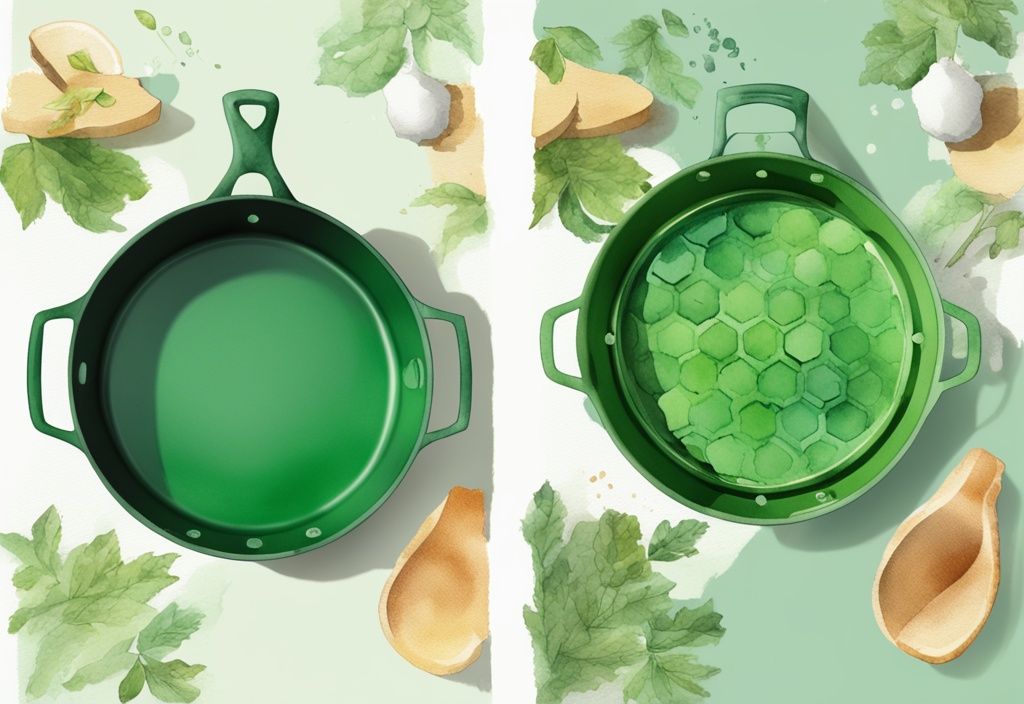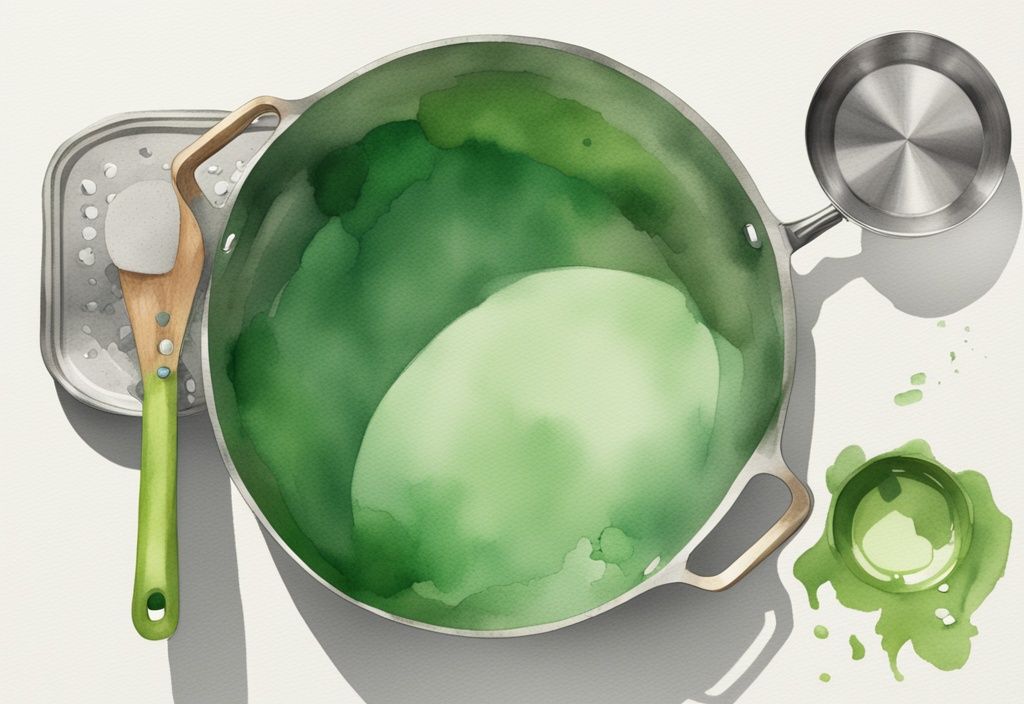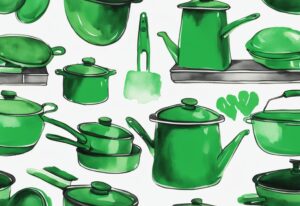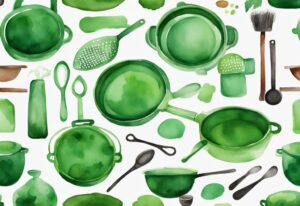HexClad vs AllClad: Unbiased Comparison Review
Are you caught in the HexClad vs All-Clad cookware dilemma? Trust me, you’re not alone. As a passionate advocate for non-toxic living, I understand the importance of choosing the right cookware. It’s not just about the cooking experience, it’s about your health too.
In this article, we’ll dive deep into the world of HexClad and All-Clad. We’ll explore their unique materials, performance, and value, to help you make an informed decision. Whether you’re a fan of HexClad’s innovative hybrid design or All-Clad’s time-tested craftsmanship, I’ve got you covered.
Join me as we discover which cookware aligns with your non-toxic living goals and culinary aspirations. Let’s make your kitchen a healthier place, one pot and pan at a time.
Introduction: HexClad and All-Clad Cookware
In the world of premium cookware, the discussion of HexClad vs AllClad cookware often sparks lively conversations among culinary enthusiasts. Both brands have made a significant mark in the industry, celebrated for their unwavering commitment to quality and performance.
All-Clad, with its rich history spanning over five decades, has firmly established itself as a leader in high-end cookware. Their collections, particularly the stainless steel and hard-anodized aluminum non-stick options, are renowned for their durability and exceptional cooking results. It’s no wonder All-Clad has become a trusted name in kitchens around the globe.
In contrast, HexClad is a relatively new entrant but has quickly captured attention with its innovative hybrid design. This groundbreaking approach marries the best of stainless steel and non-stick surfaces, offering a unique cooking experience that stands apart from traditional cookware.
When diving into the HexClad vs AllClad cookware comparison, it’s crucial to consider the variety each brand brings to the table. All-Clad boasts a wide array of collections, including stainless steel, non-stick, and copper core options, catering to diverse cooking preferences and needs. Meanwhile, HexClad focuses on perfecting a single hybrid collection, blending the benefits of both stainless steel and non-stick materials into one versatile product.
Material and Construction: HexClad vs All-Clad
When it comes to choosing cookware, understanding the material and construction can make all the difference in your cooking experience. Here, we delve into the unique features of HexClad and All-Clad, two popular choices that offer distinct benefits for your kitchen adventures.
All-Clad’s Multi-Ply Construction
All-Clad cookware has been a staple in my kitchen for years, and its reputation for quality is well-deserved. The fully-clad construction, available in options like D3 (3-ply), D5 (5-ply), and Copper Core (5-ply), ensures even heat distribution and remarkable durability. Each layer serves a purpose, creating a harmonious blend of high-quality stainless steel and hard-anodized aluminum, particularly in their non-stick collections.
What I love about All-Clad is the choice between brushed or polished finishes in their stainless steel collections. It adds a touch of elegance that complements any kitchen decor. And if you’re like me, who appreciates both style and functionality, their non-stick collections with a sleek black anodized finish are a dream come true.
HexClad’s Hybrid Design
HexClad, on the other hand, brings something truly innovative to the table with its hybrid design. The tri-ply construction features a magnetic steel base, an aluminum core, and a patented surface that combines stainless steel with non-stick material. This unique hexagon pattern of stainless steel peaks and non-stick valleys is a game-changer. It allows you to use metal utensils without worrying about damaging the surface—a feature I find incredibly practical.
The stainless steel lattice over the PTFE surface ensures even heating, providing a superior nonstick experience. This hybrid approach offers the best of both worlds, making HexClad a versatile choice for any modern kitchen. It’s perfect for those of us who want the benefits of both stainless steel and non-stick cookware without compromising on quality or performance.

Performance: HexClad vs All-Clad
When diving into the world of cookware, the choice between HexClad and All-Clad can feel overwhelming. Both brands bring unique strengths to the table, making the decision a personal journey of discovery. Let’s explore how these two giants stack up in terms of performance, focusing on heat conductivity, retention, non-stick capabilities, and surface durability.
Heat Conductivity and Retention
In my own kitchen adventures, I’ve found that heat conductivity and retention are game-changers. HexClad cookware, with its rapid heat conduction, often outpaces All-Clad, making cooking swift and energy-efficient. This means less time waiting and more time savoring your culinary creations. Both brands, however, shine in delivering even heat distribution. This ensures no pesky hot spots, just consistent results every time. When it comes to heat retention, HexClad takes the lead over All-Clad’s D3 and HA1 collections, keeping your dishes warm longer. Yet, there’s a trade-off: HexClad pans take a bit longer to heat up compared to All-Clad, which might matter if you’re eager to start cooking right away.
Non-Stick Capabilities and Surface Durability
Now, let’s chat about non-stick capabilities and surface durability. HexClad’s innovative lattice design, blending stainless steel with non-stick material, offers a robust surface that can handle metal utensils. This is a blessing for those of us who tend to be a bit rough in the kitchen. However, I’ve noticed that this non-stick surface can wear down, needing occasional seasoning to keep its charm. On the flip side, All-Clad’s non-stick pans are a dream for delicate foods like eggs, ensuring they slide right off with ease. Despite HexClad’s protective lattice, some users, myself included, have experienced food sticking to it. This can be a bit frustrating, but it’s a small hiccup in an otherwise impressive performance.
Usability: HexClad vs All-Clad
Exploring the usability of HexClad vs All-Clad cookware unveils intriguing differences that can influence your cooking experience. From handle designs to compatibility with various cooking methods, each brand offers unique features that cater to different needs and preferences.
Ease of Use and Handling
In my journey to find the perfect cookware, I’ve noticed that the design of handles plays a crucial role in the overall cooking experience. HexClad cookware, with its round and polished handles, feels like a natural extension of my hand. The comfort and secure grip they provide make even the most daunting culinary tasks feel manageable. On the flip side, All-Clad’s cup-shaped handles, while designed for enhanced grip, can sometimes feel a bit awkward. Some folks have shared that they find these handles less comfortable, which could be a minor hiccup in an otherwise stellar design.
Both brands, however, seem to share a common challenge—sticking issues with their stainless steel surfaces. It’s something to keep in mind, as it might affect your cooking flow. But don’t worry, with a bit of practice and the right techniques, you can navigate this hurdle.
Oven and Induction Compatibility
When it comes to versatility in the kitchen, HexClad vs All-Clad cookware offers some interesting options. HexClad’s compatibility with induction cooktops is a game-changer for modern kitchens. Plus, it’s oven-safe up to 500°F, which opens up a world of culinary possibilities. Imagine the joy of seamlessly transitioning from stovetop to oven without a hitch!
All-Clad, on the other hand, offers a broader temperature range with its stainless steel cookware being oven-safe up to 600°F. This can be a boon for those high-heat recipes. However, a small caveat is that their lids aren’t oven-safe, which might limit certain cooking techniques like braising. It’s a trade-off worth considering, especially if you love experimenting with different cooking methods.
In the end, choosing between HexClad and All-Clad boils down to your personal cooking style and preferences. Both brands bring something unique to the table, making the journey of selecting the right cookware an exciting adventure.
Durability: HexClad vs All-Clad
In the world of cookware, durability is a key factor when deciding between HexClad and All-Clad. Both brands have carved out a niche for themselves, known for their resilience and long-lasting performance in the kitchen.
Material Durability and Maintenance
From my own kitchen adventures, I’ve found that All-Clad cookware stands out with its solid construction. It’s like having a reliable friend who never lets you down, even after countless meals. This cookware is crafted to endure the daily hustle and bustle of cooking, retaining its performance and structure over the years.
HexClad, however, brings something unique to the table. It cleverly marries the searing prowess of cast iron with the ease of nonstick surfaces. If you’re curious about whether Ilia tests on animals, you can find more information in our detailed article on does Ilia test on animals. This innovation means you can explore various cooking techniques without worrying about wear and tear. Yet, a little care goes a long way. I always hand wash my HexClad and All-Clad pieces, even though they claim to be dishwasher safe. This simple step helps maintain the nonstick coating and extends the life of these kitchen staples.

Warranty and Customer Feedback
Both HexClad and All-Clad offer lifetime warranties, a testament to their confidence in the durability of their products. This assurance is like a comforting promise, ensuring that any manufacturing hiccups will be swiftly addressed.
Feedback from fellow home cooks is overwhelmingly positive for both brands. Many, like myself, appreciate the reliability and quality these cookware sets bring to our kitchens. It’s heartening to see so many users echoing the same sentiment—investing in HexClad or All-Clad is truly worthwhile. The glowing reviews are a testament to the satisfaction and long-term benefits experienced by those who choose these trusted brands.
Sustainability and Safety: HexClad vs All-Clad
Exploring the sustainability and safety of cookware, HexClad vs All-Clad cookware offers unique perspectives. Each brand brings its own strengths and considerations to the table, especially when it comes to non-toxicity and environmental impact.
Non-Toxicity and Environmental Impact
In my journey towards a non-toxic lifestyle, I’ve often found myself weighing the benefits of HexClad vs All-Clad cookware. All-Clad’s PTFE-free stainless steel collection has been a comforting choice for me, knowing it aligns with my values of minimizing environmental impact and avoiding harmful chemicals. This cookware eliminates PTFE, a type of PFAS, making it a more sustainable option compared to non-stick alternatives.
On the flip side, HexClad’s innovative design and non-stick convenience have their own allure; if you’ve been worried about PFAs, a.k.a. per- and poly-fluoroalkyl substances, you can learn more about their health and environmental impacts here. Yet, I can’t help but be cautious about the usual concerns surrounding non-stick materials, particularly in terms of toxicity and sustainability. It’s a balancing act between convenience and conscientious living.
PTFE and PFAS Concerns
The discussion around HexClad vs All-Clad cookware inevitably touches on PTFE and PFAS concerns. Both brands use PTFE in their non-stick offerings, which is a type of PFAS, although they are PFOA-free. This addresses some health concerns, but for those like me who are deeply invested in sustainability and reducing chemical exposure, All-Clad’s PTFE-free stainless steel cookware stands out as a preferred choice.
Choosing this option feels like a step towards a more environmentally conscious lifestyle, providing a safer alternative without sacrificing performance. While HexClad offers a unique cooking experience, if you’re like me and have heightened concerns about chemical exposure, All-Clad’s PTFE-free options might resonate more with your values.
Value for Money: HexClad vs All-Clad
Choosing cookware is more than just a kitchen decision; it’s about investing in your culinary journey and well-being. In this section, we delve into the cost and long-term value of HexClad and All-Clad cookware, helping you make an informed choice that aligns with your lifestyle and values.
Cost Comparison
When I first started exploring the world of premium cookware, the question of cost was at the forefront of my mind. Both HexClad and All-Clad are renowned for their high-quality materials and craftsmanship, but they cater to different budgets. All-Clad, with its range of options, particularly shines in its non-stick cookware line, offering a more budget-friendly entry point. This makes it a fantastic choice for those of us who want quality without stretching our wallets too thin.
HexClad, on the other hand, captivated me with its unique hybrid design. Yes, it comes with a higher price tag, but for those who value innovation and versatility, it might just be worth the splurge. If you’re considering a long-term investment, All-Clad’s PTFE-free stainless steel options are not only durable but also kinder to the environment, which is a significant factor for many of us striving for a non-toxic lifestyle.
Long-Term Investment Value
Thinking about the long-term value of cookware can feel daunting, but it’s an essential part of the decision-making process. All-Clad’s reputation is built on decades of reliable performance and a diverse range of collections. This makes it a go-to for those of us who prioritize durability and consistency in our kitchen tools.

HexClad, however, offers something different. Its hybrid design, combining stainless steel and non-stick surfaces, provides a level of flexibility that I find incredibly appealing. For home cooks who love adaptability, this could be a game-changer.
Ultimately, the choice between HexClad and All-Clad boils down to what you value most in your cookware. Whether it’s design, functionality, or budget, both brands offer distinct advantages that cater to different culinary needs. Remember, the right choice is the one that feels right for you and your kitchen adventures.
Conclusion: HexClad vs All-Clad – Which is Better?
Choosing between HexClad and All-Clad cookware is a journey that reflects your personal cooking style and values. I’ve always believed that our kitchens are extensions of ourselves, and the tools we choose should resonate with our needs and aspirations. All-Clad has been a staple in my kitchen for years, and its reputation for durability is well-earned. With its multi-ply construction, it offers a range of collections that cater to diverse cooking needs. Whether you’re simmering a delicate sauce or searing a steak, All-Clad’s stainless steel and non-stick options provide reliability and performance that stand the test of time.
For those interested in health-conscious cooking, exploring glyphosate-free oats can be a great addition to your culinary repertoire. Yet, my curiosity led me to explore HexClad, and I was intrigued by its innovative hybrid design. Combining stainless steel with non-stick surfaces, HexClad offers a unique cooking experience. Its distinctive hexagon pattern not only enhances non-stick capabilities but also allows the use of metal utensils without fear of damage. This versatility is a game-changer for those who, like me, appreciate innovation and adaptability in their kitchen tools.
For some, the idea of investing in separate high-quality stainless steel and non-stick pans might seem more practical. This approach allows for specialized cookware tailored to specific tasks, potentially offering enhanced performance and longevity. Ultimately, the choice between HexClad vs All-Clad cookware is deeply personal. It hinges on your cooking habits, budget, and the balance you seek between tradition and innovation.
In my own journey, I’ve found that both brands offer unique benefits. Whether you lean towards the time-tested reliability of All-Clad or the cutting-edge versatility of HexClad, the decision is about aligning your cookware with your culinary aspirations. Remember, the heart of non-toxic living is making choices that reflect your values and support your well-being. Happy cooking!
FAQ
What makes HexClad cookware unique?
HexClad cookware truly stands out with its patented hexagon pattern. This design ensures even heating and provides a nonstick surface. I remember the first time I used HexClad; I was amazed by how I could use metal utensils without worrying about scratches. This hybrid design offers both versatility and durability, making it a reliable choice for any kitchen.
Is All-Clad cookware worth the investment?
Investing in All-Clad cookware is like investing in a lifelong cooking partner. Its robust, multi-ply stainless steel construction ensures long-lasting performance. With a wide range of collections, All-Clad caters to diverse cooking needs and preferences. Personally, I’ve found that its durability and performance make it a staple in my kitchen.
How do HexClad and All-Clad handle non-stick surfaces?
When it comes to non-stick surfaces, HexClad requires a bit of care as its surface may degrade over time and needs seasoning. On the other hand, All-Clad’s non-stick pans offer superior food release, especially for delicate foods. I often find myself reaching for All-Clad when cooking everyday meals, as it makes the process seamless and enjoyable.
Which brand is more suitable for induction cooking?
Both HexClad and All-Clad are great for induction cooking. HexClad is fully induction-compatible, and most All-Clad collections work well with induction cooktops too, except for the Essentials collection. This makes both brands viable options if you’re cooking on an induction stove, which I find particularly efficient and eco-friendly.
Are there any safety concerns with HexClad or All-Clad cookware?
Safety is always a priority in my kitchen. Both brands’ non-stick cookware contains PTFE, a type of PFAS, but they are PFOA-free. If you’re concerned about sustainability and toxicity, All-Clad’s PTFE-free stainless steel cookware is a great alternative. It’s reassuring to know that there are options that align with a commitment to a healthier lifestyle.
Hi, I’m Olivia Green, the voice behind nontoxicways.com. I’m passionate about helping you make the shift to a healthier, non-toxic lifestyle without feeling overwhelmed. I love sharing my personal journey, from small changes to big transformations, along with practical tips that make it all feel doable. My goal is to inspire and guide you toward a lifestyle that benefits both your well-being and the planet. Let’s take this journey together, one simple step at a time!














Post Comment